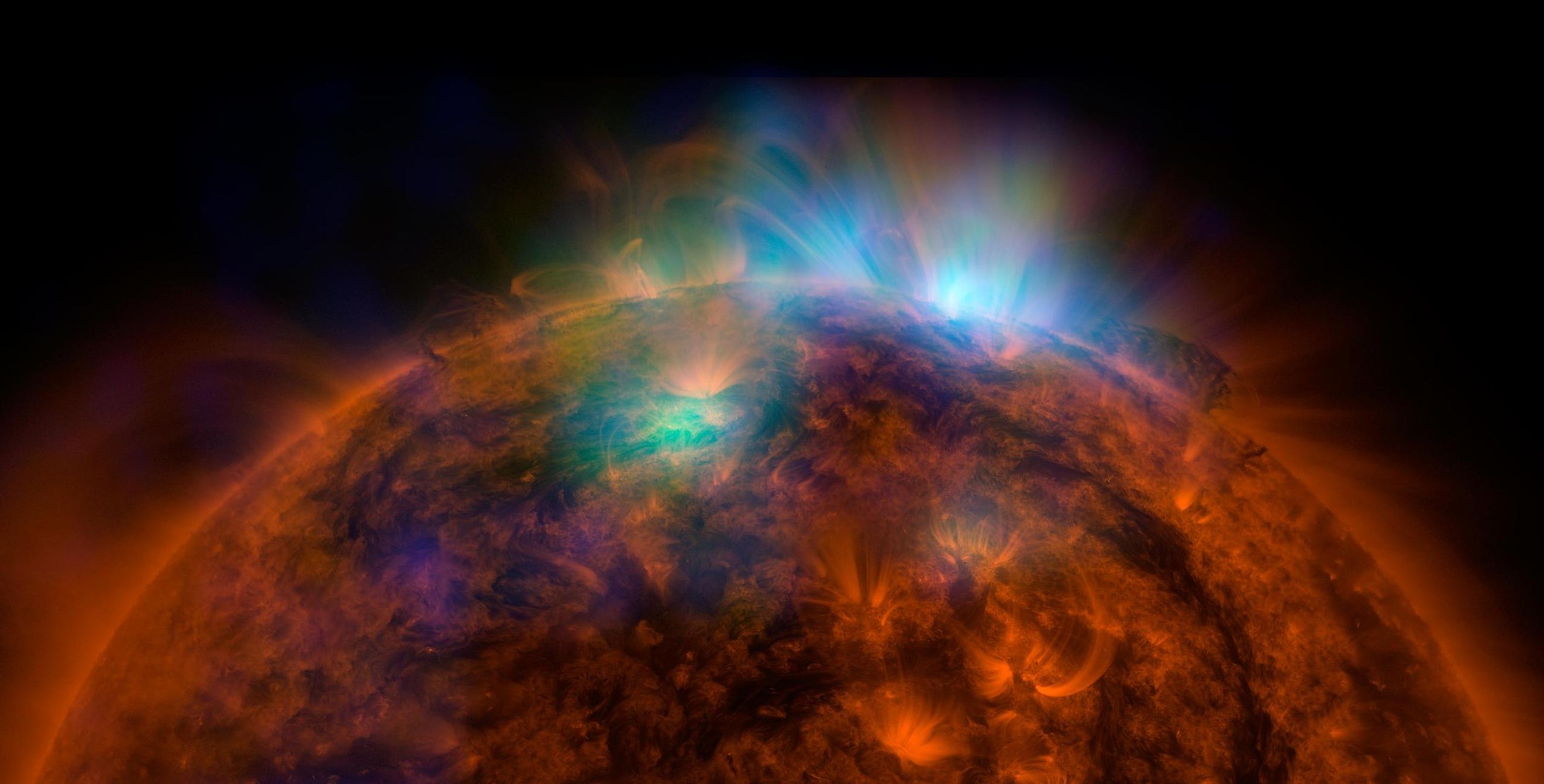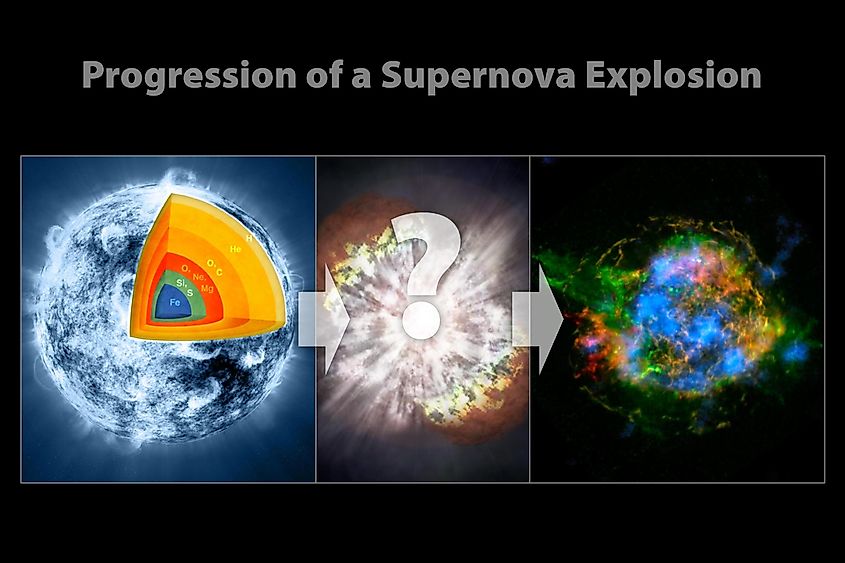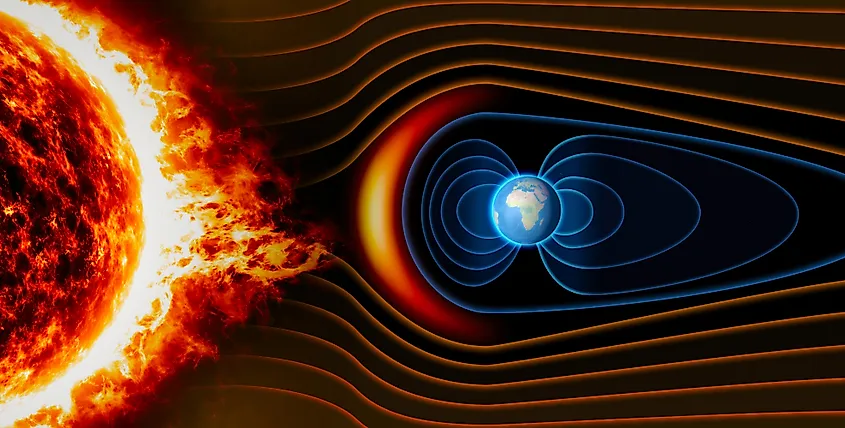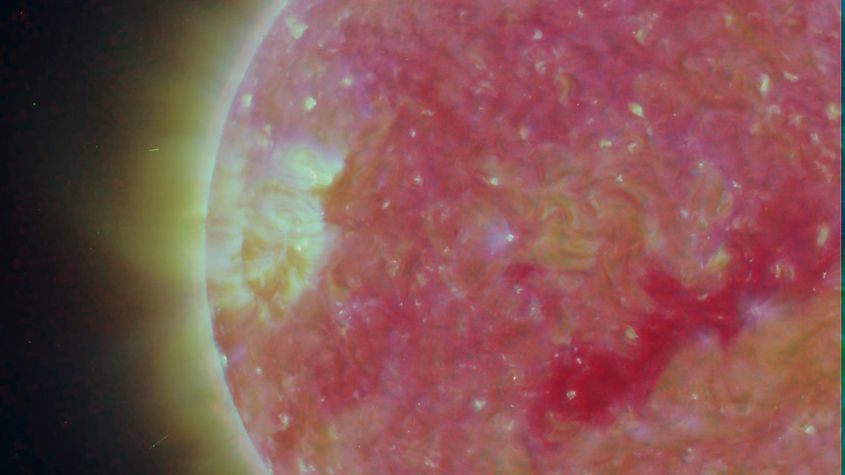
The Sun
The sun is the nearest star to the Earth, and it is the powerhouse of the solar system. More than 99% of all the mass in the solar system is contained within the sun, making it the strongest gravitational influence in the solar system. In terms of size and mass, the sun is a true behemoth. By mass, the sun is 333,000 times the mass of Earth. The sun is 864,000 miles (1.39 million kilometers) across, or about 109 times larger than Earth. By volume, you could fit over one million Earths inside the sun. It has an average surface temperature of 10,000 degrees Fahrenheit (5,500 degrees Celsius), yet its core temperature exceeds 27 million degrees Fahrenheit (15 million degrees Celsius). This core temperature is very important. A star must have at least this temperature in the core because it's at this temperature that the process of nuclear fusion occurs.
The extreme temperatures and pressures in the sun cause hydrogen nuclei to fuse. The fusion process eventually gives rise to helium through a proton-proton chain, the second most abundant element in the sun. This fusion process gives off a tremendous amount of energy by converting some of the mass involved in the reaction into energy. Interestingly, the combined mass of the atoms coming together is greater than that of the atom produced. For years, this was a mystery until Albert Einstein formulated his famous formula, E=mc^2. This simple yet profound equation showed that energy and mass are the same, and one can be converted to the other. Some mass is converted into energy during the fusion process, and it's this energy that powers the sun. The outward flow of energy and the inward pull of the sun's gravity create a hydrostatic equilibrium, meaning that both the energy produced and the inward pull of gravity balance each other out, allowing the sun to maintain its stability for billions of years.
Evolution Of The Sun

The sun formed around 4.5 billion years ago. Since no one was around to observe the sun's formation, astronomers relied on observing other sun-like stars in the Milky Way to understand how the sun formed and evolved through time. Every star in the universe forms in virtually the same way. The life of a star begins with the gradual clumping of vast clouds of hydrogen gas, generally located within a star-forming region called a nebula. It is rare for stars to form alone, typically formed alongside several other stars. The sun is no exception, and it's more than likely that the sun formed within a neighborhood of other stars. Some external force usually ignites star formation, typically the formation of a nearby star, a nearby supernova, or a galactic merger event. These processes will raise the temperature of hydrogen gas clouds and cause them to stick together. As more hydrogen clumps together, its gravitational pull increases. The process becomes exponential, with the increasing mass causing gravity to become stronger. Once temperatures and pressures become high enough, the process of nuclear fusion ignites, and the star is born. Not all of the stellar material forms the star. However, Some of it falls into orbit around the star and becomes a protoplanetary disk. Throughout many millions of years, the debris within the protoplanetary disk will merge to form a multitude of planets. When the sun first formed, it was colder than it is today. Over time, stars tend to get hotter, which has a profound impact on the planets. For example, the lower temperature of the young sun meant that the sun's habitable zone was closer to the sun than it is today. In fact, Venus likely orbited within the sun's habitable zone many billions of years ago, and there is chemical evidence on the surface of Venus that suggests the planet once had liquid water.
After the sun formed, it became what's known as a main-sequence star, meaning that it is actively fusing hydrogen and helium in its core. The sun will remain in the main sequence for about ten billion years. Over time, the sun's temperature and size are gradually increasing. Since its formation, the sun has increased its radius by about 15%, and temperatures have increased by about 3%. Together, these have increased the luminosity of the sun by 48%. The sun's luminosity rises by about 1% every 100 million years.
Solar Cycle

The sun experiences an 11-year cycle directly tied to the number of sunspots on the sun's surface. There are two phases during this cycle: maximum and minimum. As their names suggest, the maximum is when the sunspots reach their peak, while the minimum is when the lowest number of sunspots are detected. The 11-year cycle spans from one minimum to the next, with the maximum occurring between. The process begins as sunspots form on the sun's surface and move towards the sun's equator. Once the sunspots reach the equator, a solar minimum occurs. The number of sunspots is significantly higher than during a solar minimum during a solar maximum. Although sunspots are colder and dimmer than the surrounding area, the sun becomes hotter when more sunspots are present. The existence of more sunspots also translates to more solar flares, which can occur every day during solar maximum.
The solar cycle has a profound impact on our world. As solar flares become more abundant, more solar radiation interacts with the Earth's atmosphere. For the most part, the Earth is protected from solar radiation by its magnetic field and the ozone layer. Some of the charged particles from the sun caught in our magnetic field are redirected towards the Earth's poles. These charged particles interact with and ionize the particles in our atmosphere, stripping them of their electrons and releasing photons. This process is what generates the aurora on Earth.
The Solar Wind

The solar wind is a stream of charged particles released by the sun. The solar wind is divided into different types depending on where they are released on the sun's surface. There is the slow solar wind and the fast solar wind. The slow solar wind generally has a speed of 500 km/s near the Earth, while the fast solar wind moves at 750 km/s. The slow solar wind is also about twice as dense as the fast solar wind.
Interestingly, the speed at which the solar wind moves is dependent on the location it originates from. The slow solar wind originates in the Streamer Belt, located at the sun's equator. Meanwhile, the fast solar wind appears to develop near the sun's poles.
The solar wind can damage a planet's atmosphere if it does not have a magnetic field to redirect the solar wind. If the Earth did not have a magnetic field, the solar wind would slowly erode our atmosphere, and life would be impossible. The solar wind is likely responsible for the lack of an atmosphere on Mars. Mars lost its magnetic field long ago, so it no longer possesses any protection from the solar wind. Over time, the solar wind eroded the Martian atmosphere.
Solar Flares

Although it appears relatively calm from our tiny rock, the sun is bursting with energy. Occasionally, the sun releases large bands of energy called solar flares, some of which are many times larger than the Earth. Solar flares are some of the most energetic events in our solar system. Two main factors lead to their formation. Firstly, the entire sun does not rotate at the same speed. Instead, the equator rotates faster than the poles, completing an orbit within 25 days compared to 38 days for the poles. Secondly, the sun's magnetic field can temporarily prohibit convection currents that cause some regions to become cooler than others, forming what are called sunspots. Sunspots form in pairs and behave like a magnet: one sunspot is positive while one is negative with magnetic field lines connecting them. As the sun rotates at varying speeds, sunspots cannot move in lockstep with each other. Instead, they move at different speeds, which can cause the magnetic field lines between them to tangle and stretch. When they become stretched too far, they can snap like a rubber band, unleashing their pent-up potential energy, reaching as high as 10^25 joules, or the equivalence of 2.5 million atomic bombs (100 megatons per bomb).
The Sun's Future
The sun is approximately halfway through its life, and it still has another 4.5 billion years to go. The sun is a relatively low mass star, and it contains nowhere near enough mass to become a supernova. Instead, the sun will one day evolve into a red giant, which will eventually become a white dwarf. Although the sun contains a vast amount of hydrogen, it is still only a finite amount. The sun is constantly fusing hydrogen into helium in its core, and eventually, the sun will run out of usable hydrogen. When this occurs, the sun's state of equilibrium will be broken, and the sun's gravitational pull will begin to compress the sun. However, by compressing the core, temperatures increase, allowing the sun to fuse even heavier elements in its core. The sun will begin to expand many times beyond its original size. The sun will become a giant red star, which will become so large that it may even swallow the Earth. The sun will become so large that its gravity will no longer be strong enough to hold onto the outer layers. Over time, the sun will expel its outer layers into space. All that will remain is a shell of stellar material called a planetary nebula. The sun's core will transform into a white dwarf star and will likely shine for many trillions of years.
| Diameter | 864,000 miles (1.39 million kilometres) |
|---|---|
|
Mass |
333,000 Earths (One solar mass) |
|
Surface temperature |
5,778 Kelvin |
|
Core temperature |
27 million degrees Fahrenheit (15 million degrees Celsius) |
|
Composition |
75% hydrogen, 25% helium |











